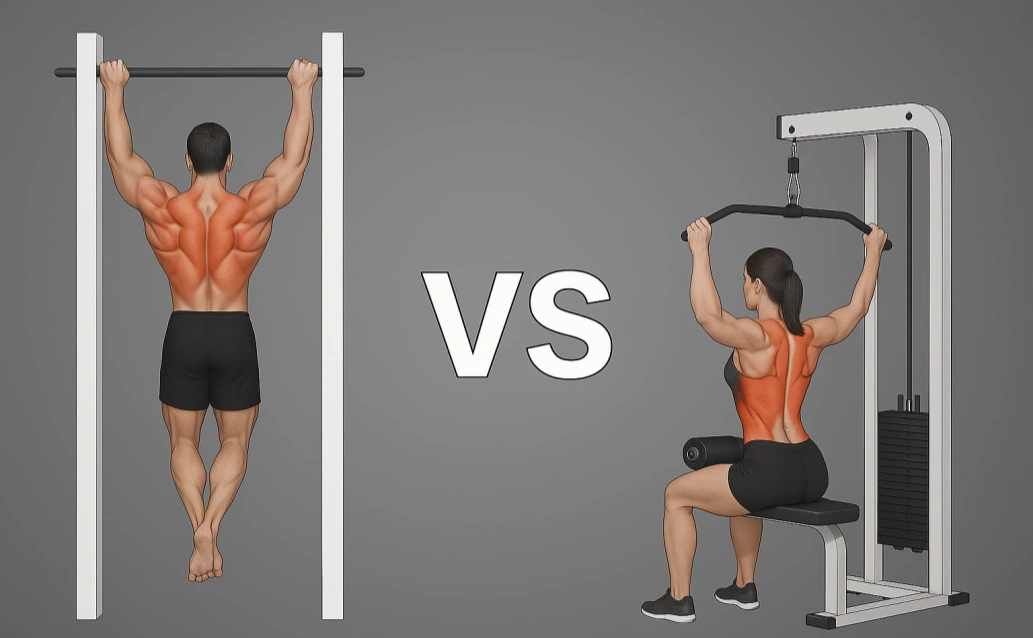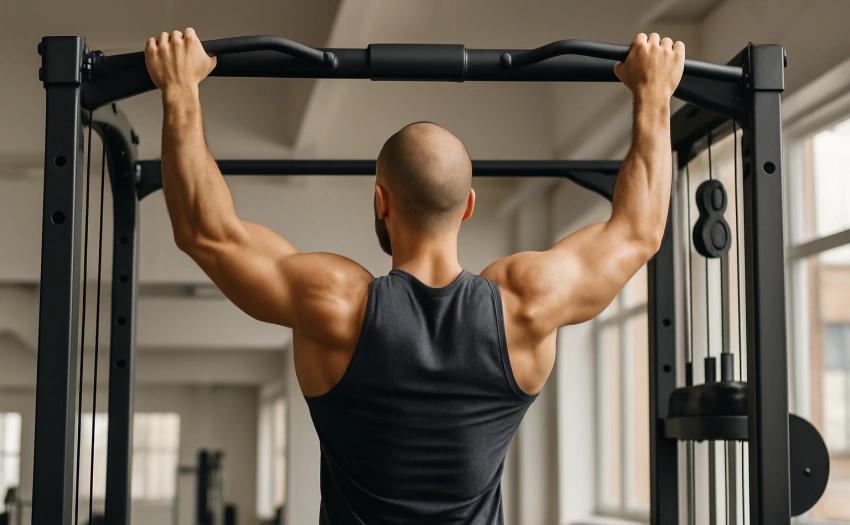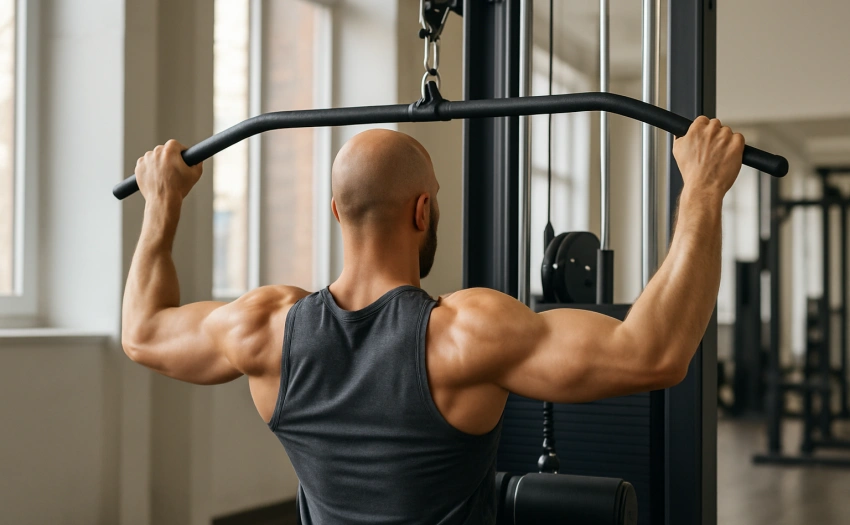
Lat pulldown vs pull-up — I used to think the difference didn’t matter.
They both hit your lats, right? Same basic movement: you pull something toward your chest. But here’s the thing — pull-ups make you move your whole body through space, while pulldowns let you stay seated and just move the weight. One demands total body control. The other gives you more stability.
For months, I trained my back almost entirely on lat machine pulldowns — mostly lat pulldowns and rows. They were easy to load, easy to progress, and honestly, felt like enough.
So I stopped doing pull-ups altogether.
But a few days ago, just out of curiosity, I jumped on the pull-up bar. No weight, no plan — just a few clean reps, full range.
The next day, my lats were wrecked. Not “good sore.” I mean sore-to-the-touch, twisting-hurts, what-did-I-just-do sore.
That stopped me in my tracks.
Were pull-ups just harder? Or had I been missing something this whole time?
That question stuck with me. If I was training hard, why did a few pull-up reps hit so much deeper than weeks of pulldowns?
So I decided to run a little test.
Just to be clear, this wasn’t some big program change — I literally added three sets of bodyweight pull-ups at the end of a regular back day. That’s it.
Here’s what I did:

Now here’s the thing — I used to knock out 10+ reps without even thinking. But this? This was humbling.
And what really hit me wasn’t the numbers — it was how my back felt the next day.
We’re talking sore-to-the-touch, deep, twisting-hurts type of sore.
It made me realize: I’d been training hard, but maybe not training deep.
So I sat down and started thinking: what’s really going on here?
Why did just a few sets of pull-ups hit me harder than weeks of lat pulldowns?
Here’s how the two movements actually stack up — based on what I felt in my own body, not just theory.
| Category | Pull-Up | Lat Pulldown |
|---|---|---|
| Muscle Engagement | Full upper body: lats, traps, biceps, core, grip | More isolated to lats and upper back |
| Stability Required | Requires full-body tension and control | Supported and stable; no need for core involvement |
| Progression | Harder to scale; stuck with bodyweight or weighted | Easily adjustable in small weight increments |
| Fatigue & Soreness | Very fatiguing; deep DOMS, slower recovery | Easier recovery, even after high volume |
| Accessibility | Challenging for beginners; strength barrier | Beginner-friendly; accessible to all levels |
| Training Style | Intense, athletic, total-body movement | Controlled, hypertrophy-focused, volume-friendly |
After those pull-ups wrecked my back, I knew I couldn’t just go back to machines and pretend everything was fine.
Sure, I still liked lat pulldowns — they’re smooth, easy to load, and always give me a great pump.
But clearly, they don’t hit the same.
That’s when I stopped choosing between the two. Instead, I decided to use both — and honestly? Best move I’ve made in a while.
🔹 First Up: Pull-Ups (Even When They Feel Brutal)
These days, I always start my back workouts with pull-ups. Not because they’re easy (they’re not), but because they force me to show up — fully.
Some days I can do 6–8 clean reps, other days I’m grinding just to hit 4.
Still, I do them anyway. Because pull-ups activate everything: lats, core, grip, even your headspace.
I usually go for 3–4 sets, full range, no momentum. If I’m feeling good, I’ll throw on a weight belt.
If not? Bodyweight keeps me honest.

And when you hit a clean, strong set? Feels GOOD.
No machine gives me that.
And it’s not just me feeling this.
A study in the Journal of Strength and Conditioning Research actually showed that pull-ups activate more muscle — especially in the lats and core — than lat pulldowns.
🔹 Next: Lat Pulldowns (Time to Chase the Burn)
After pull-ups, I move straight into lat pulldowns. By now, my lats are awake and ready to be worked.
Here’s where I chase the pump. I’ll hit 4–5 sets, switch up grips (wide, close, underhand), slow down the reps, and squeeze like crazy.
I’m not going for max weight here. Instead, it’s all about control and feeling that deep burn.
That pump? Perfect combo.

This wasn’t about finding the “better” exercise.
It was about realizing I’d been getting stronger — but not sharper.
Pull-ups reminded me what full-body effort feels like.
Pulldowns reminded me why control still matters.
I used to avoid one and rely too much on the other.
Now? I just use both — and my back’s never felt better.
I’m getting stronger, my lats are finally popping, and I actually feel the work deep where it counts.
So yeah, it took getting sore as hell to figure it out.
But I’m glad I did.
So if you’ve been avoiding pull-ups, like I did for way too long…
Stop waiting. Do a set. Feel it for yourself.
Your back will know the truth real.
No, pull-ups can work your lats well on their own. However, lat pulldowns can help if you’re looking to target your lats more or increase volume without doing more pull-ups.
Lat pulldowns can help build strength for pull-ups, but they don’t directly convert to pull-up ability. Pull-ups require full-body engagement and stabilizers that pulldowns don’t target.
I’m Jessica Camp, a passionate fitness enthusiast and the creative force behind Inpek Fitness’s content. With over a decade in the fitness industry, I combine my expertise in exercise science with a deep knowledge of commercial gym equipment. I’m dedicated to promoting health and wellness by sharing valuable tips, training techniques, and the latest trends in Pin Loaded Machines, Plate Loaded Machines, Multi Function Gym Machines, Gym Multi, and Free Weights. Whether you’re a gym owner or a fitness enthusiast, my articles are crafted to inspire and empower you to reach your fitness goals. When I’m not writing, I love working out and exploring innovative fitness solutions.
Looking to enhance your gym with premium equipment? Have inquiries or ideas? Complete the form below to engage with our expert team. We’ll work with you to realize your fitness facility goals efficiently and effectively.